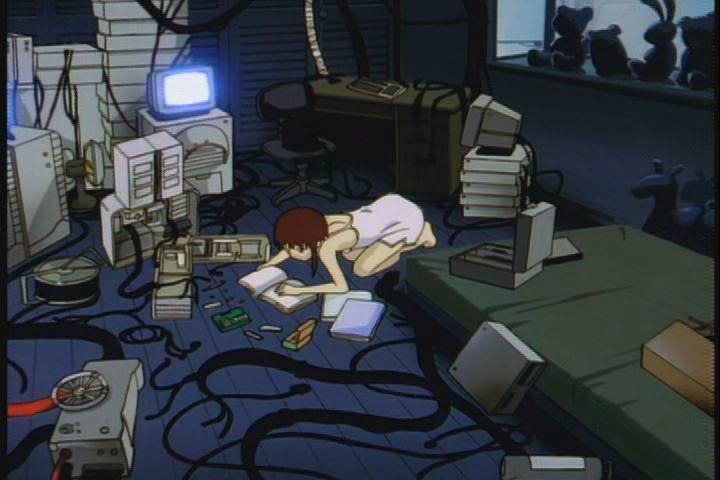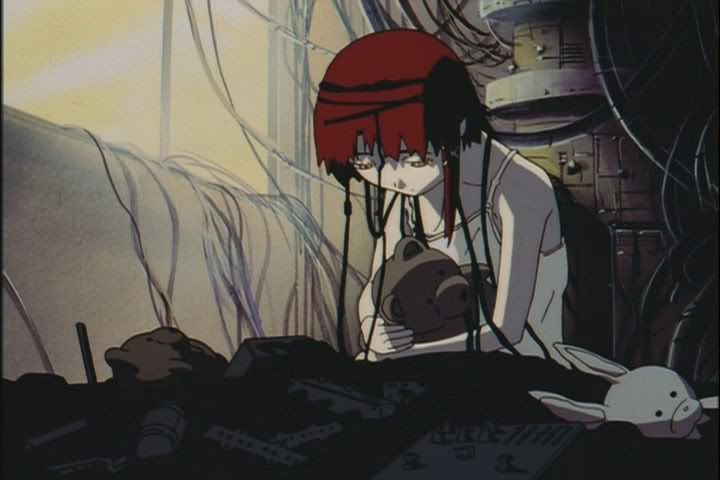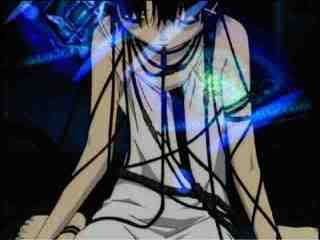 Title: Serial Experiments Lain
Title: Serial Experiments Lain
Rating: 4/5
Genre: Sci Fi, Mystery, Anime, Series
Duration: 25 mins (13 eps)
Director: Ryutaro Nakamura
Language: Japanese
 Serial Experiments Lain is most certainly a mindfuck, but there are always many different kinds of mindfucks; there's the ones that start off making little sense but by the end have you completely bewildered as to what just happened (E.g. Lynch's works), then there's the kind that make very little sense until you finally discover that one snippet of information that allows you to decipher the events shown (Gozu or Paranoia Agent for example), but this one feels slightly different to these common examples. Instead of seeming cryptic it feels that they're firing information at you like water out of a high pressure hose but all you have to catch it with is a paper bag; it feels as though it should make sense as you steadily uncover clues and rapidly attempt to fit them together, forming an image steadily increasing in size but never becoming all that much clearer and every time you think you've figured it out, the next episode (or 'layer' as it is more aptly called) adds insult to injury and painfully points out that actually, you really haven't.
Serial Experiments Lain is most certainly a mindfuck, but there are always many different kinds of mindfucks; there's the ones that start off making little sense but by the end have you completely bewildered as to what just happened (E.g. Lynch's works), then there's the kind that make very little sense until you finally discover that one snippet of information that allows you to decipher the events shown (Gozu or Paranoia Agent for example), but this one feels slightly different to these common examples. Instead of seeming cryptic it feels that they're firing information at you like water out of a high pressure hose but all you have to catch it with is a paper bag; it feels as though it should make sense as you steadily uncover clues and rapidly attempt to fit them together, forming an image steadily increasing in size but never becoming all that much clearer and every time you think you've figured it out, the next episode (or 'layer' as it is more aptly called) adds insult to injury and painfully points out that actually, you really haven't.
With Lain taking the central role, this series chronicles her journey of self-discovery, exploring the intricacies of 'The Wired' (a parallel form of the internet), steadily becoming further obsessed with its potential power and the mysterious occurrences that surround her somehow linked to this virtual reality. Explaining in any more detail the plot would be robbing it of its greatest strength as it twists and turns and subtle clues stack up until your own revelations occur and another piece of the puzzle has been uncovered. It never stops feeding you information regardless of whether you realise it or not, and often episodes need time to be properly digested and considered; if you race through in one sitting many of the intricacies may rapidly become lost, and as each new layer gets put into place adequate understanding of the simpler layer that preceded it may fail to emerge (though this certainly isn't to suggest you should try to figure out everything by the end of the first episode else you wont get anywhere, but merely allow it time to sink in). Impressively, by the conclusion enough has been explicitly said and arranged such that the attentive can extract sense from the story and answer the question of just who Lain really is, even if the finer details still require more thought.

At over a decade old now the animation style certainly looks dated but its certainly not without consideration, the characters in particular designed by the man who would later go on to work on the artwork for 'Haibane Renmei' (and provide its best feature). With a focus on Lain herself, the other characters remain very similar in appearance from start to finish allowing the gradual change in Lain to show itself, her clothing and attitude showing the transitions from the quiet, shy and naïve child into something far more extrovert and wild; transforming from one extreme all the way to the absolute opposite. This is unquestionably a thinker, and whilst not perfect certainly succeeds in making you think.
Watched it and still haven't the foggiest?
» Click to show Spoiler - click again to hide... «
 Ok, so I wont explain all the intricacies but certainly just the concept of who Lain truly is. The first big thing to tackle is that Lain, in a sense, never truly existed. There are constant reminders of the power of memory manipulation; characters stating that they 'remember seeing Lain' in Cyberia or on the wired. The truth is that their memories are seeing a constant update of new information, falsified memories of seeing Lain, and this is the crux of the series so bear with me if I take some time explaining it properly.
Ok, so I wont explain all the intricacies but certainly just the concept of who Lain truly is. The first big thing to tackle is that Lain, in a sense, never truly existed. There are constant reminders of the power of memory manipulation; characters stating that they 'remember seeing Lain' in Cyberia or on the wired. The truth is that their memories are seeing a constant update of new information, falsified memories of seeing Lain, and this is the crux of the series so bear with me if I take some time explaining it properly.
A memory is simply a sequence of actions that we can recall occurring. If this sequence of actions was implanted then it would yield the memory of something which never truly occurred (though arguably if everyone believes the same sequence occurred then it did, Lenin's old phrase of “A lie told often enough becomes the truth” springs to mind). A memory doesn't explicitly mention a time duration, it can be as long as a decade or as short as a nanosecond, and if we just consider the latter then by feeding someone a constant stream of updated memories, we can 'exist' in a very real way in a physical reality. (When Eiri – the Knight who created Lain – attempts to upload this information in a similar manner in order to give himself a physical body, he fails and as a result implodes).
But this still doesn't truly explain who Lain truly is, simply how she is able to interact across the two realities. As was mentioned Lain is 'software,' designed by the Knights and implanted into the vastness of Protocol Seven. The software is an extension of the experimental 'KIDS' program mentioned early on, harnessing the Psi energy from all humanity linked in a universal network formed by the Schumann resonance into a single location: Lain.
Since Psi energy is more potent in children, this is why Lain's physical form is that of a child. Likewise, the code itself is experimental and filled with a number of bugs to be updated, the major one of which is successfully combining all the Psi energy into a single entity, and results in her multiple personalities. The best analogy I can think for this is to consider a torrent where each person is uploading their personality. Far from there being a universal tracker, one may be filled with horror films, snuff, child pornography and so on, whilst another may mostly consist of pictures of kittens and children's programs. Each 'split' of this whole network is thus characterised very differently and is represented in her overarching character. More than mono-dimensional, particularly in the early scenes we see even her 'shy' character slowly fluctuate in personality which again supports this idea of a constant flow of information.
 When Lain uncovers her power she is able to filter the information allowed access – think of a firewall perhaps – and as a result settle into a single 'set' personality. Lain's Father (I suspect that he is is head of the division leading Protocol Seven, though we only know for sure that he is an employee) soon discovers the existence of Lain within the code but rather than attempt to start writing again from scratch, he decides to construct a family to influence her decision making abilities and act as something of an artificial intelligence (there is mention that “work to remove Lain's software from the program is already underway”); a program capable of monitoring the flow of information within the wired. This means 'raising' her to come to a different conclusion than the one Eiri would have her believe, Eiri wanting to use her ability as a means to monitor the world
When Lain uncovers her power she is able to filter the information allowed access – think of a firewall perhaps – and as a result settle into a single 'set' personality. Lain's Father (I suspect that he is is head of the division leading Protocol Seven, though we only know for sure that he is an employee) soon discovers the existence of Lain within the code but rather than attempt to start writing again from scratch, he decides to construct a family to influence her decision making abilities and act as something of an artificial intelligence (there is mention that “work to remove Lain's software from the program is already underway”); a program capable of monitoring the flow of information within the wired. This means 'raising' her to come to a different conclusion than the one Eiri would have her believe, Eiri wanting to use her ability as a means to monitor the world
There are still details to work out – her sister and friend's place in the story in particular – but the core of the story certainly fits my conclusion.

 Serial Experiments Lain is most certainly a mindfuck, but there are always many different kinds of mindfucks; there's the ones that start off making little sense but by the end have you completely bewildered as to what just happened (E.g. Lynch's works), then there's the kind that make very little sense until you finally discover that one snippet of information that allows you to decipher the events shown (Gozu or Paranoia Agent for example), but this one feels slightly different to these common examples. Instead of seeming cryptic it feels that they're firing information at you like water out of a high pressure hose but all you have to catch it with is a paper bag; it feels as though it should make sense as you steadily uncover clues and rapidly attempt to fit them together, forming an image steadily increasing in size but never becoming all that much clearer and every time you think you've figured it out, the next episode (or 'layer' as it is more aptly called) adds insult to injury and painfully points out that actually, you really haven't.
Serial Experiments Lain is most certainly a mindfuck, but there are always many different kinds of mindfucks; there's the ones that start off making little sense but by the end have you completely bewildered as to what just happened (E.g. Lynch's works), then there's the kind that make very little sense until you finally discover that one snippet of information that allows you to decipher the events shown (Gozu or Paranoia Agent for example), but this one feels slightly different to these common examples. Instead of seeming cryptic it feels that they're firing information at you like water out of a high pressure hose but all you have to catch it with is a paper bag; it feels as though it should make sense as you steadily uncover clues and rapidly attempt to fit them together, forming an image steadily increasing in size but never becoming all that much clearer and every time you think you've figured it out, the next episode (or 'layer' as it is more aptly called) adds insult to injury and painfully points out that actually, you really haven't.
 Ok, so I wont explain all the intricacies but certainly just the concept of who Lain truly is. The first big thing to tackle is that Lain, in a sense, never truly existed. There are constant reminders of the power of memory manipulation; characters stating that they 'remember seeing Lain' in Cyberia or on the wired. The truth is that their memories are seeing a constant update of new information, falsified memories of seeing Lain, and this is the crux of the series so bear with me if I take some time explaining it properly.
Ok, so I wont explain all the intricacies but certainly just the concept of who Lain truly is. The first big thing to tackle is that Lain, in a sense, never truly existed. There are constant reminders of the power of memory manipulation; characters stating that they 'remember seeing Lain' in Cyberia or on the wired. The truth is that their memories are seeing a constant update of new information, falsified memories of seeing Lain, and this is the crux of the series so bear with me if I take some time explaining it properly. When Lain uncovers her power she is able to filter the information allowed access – think of a firewall perhaps – and as a result settle into a single 'set' personality. Lain's Father (I suspect that he is is head of the division leading Protocol Seven, though we only know for sure that he is an employee) soon discovers the existence of Lain within the code but rather than attempt to start writing again from scratch, he decides to construct a family to influence her decision making abilities and act as something of an artificial intelligence (there is mention that “work to remove Lain's software from the program is already underway”); a program capable of monitoring the flow of information within the wired. This means 'raising' her to come to a different conclusion than the one Eiri would have her believe, Eiri wanting to use her ability as a means to monitor the world
When Lain uncovers her power she is able to filter the information allowed access – think of a firewall perhaps – and as a result settle into a single 'set' personality. Lain's Father (I suspect that he is is head of the division leading Protocol Seven, though we only know for sure that he is an employee) soon discovers the existence of Lain within the code but rather than attempt to start writing again from scratch, he decides to construct a family to influence her decision making abilities and act as something of an artificial intelligence (there is mention that “work to remove Lain's software from the program is already underway”); a program capable of monitoring the flow of information within the wired. This means 'raising' her to come to a different conclusion than the one Eiri would have her believe, Eiri wanting to use her ability as a means to monitor the world 

Comments
Post a Comment